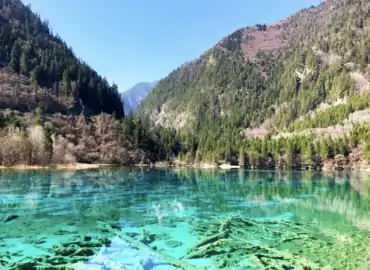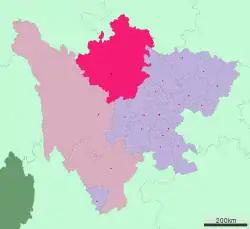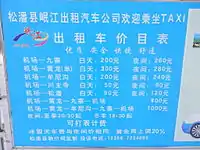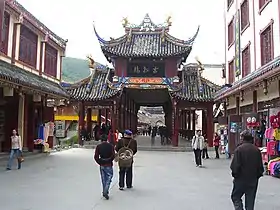Ngawa Tibetan and Qiang Autonomous Prefecture
Ngawa Tibetan and Qiang Autonomous Prefecture, also known as Aba (Tibetan: རྔ་བ་བོད་རིགས་དང་ཆང་རིགས་རང་སྐྱོང་ཁུལ་, Wylie: rnga ba bod rigs cha'ang rigs rang skyong khul; Qiang: Rrmeabba Shbea Rrmea Nyujwju Gvexueaj Legea; simplified Chinese: 阿坝藏族羌族自治州; traditional Chinese: 阿壩藏族羌族自治州), is an autonomous prefecture of northwestern Sichuan, bordering Gansu to the north and northeast and Qinghai to the northwest. Its seat is in Barkam, and it has an area of 83,201 km2 (32,124 sq mi). The population was 919,987 in late 2013.[2]
Aba Prefecture
阿坝州 · རྔ་བ་ཁུལ། · Rrmeabba Legea | |
|---|---|
阿坝藏族羌族自治州 · རྔ་བ་བོད་རིགས་ཆ་བ༹ང་རིགས་རང་སྐྱོང་ཁུལ · Rrmeabba Shbea Rrmea Nyujwju Gvexueaj Legea Ngawa Tibetan and Qiang Autonomous Prefecture | |
 | |
 Ngawa-Qiang Autonomous Prefecture (top centre) in Sichuan | |
| Coordinates (Ngawa Prefecture government): 31.90°N 102.22°E | |
| Country | China |
| Province | Sichuan |
| Prefecture seat | Barkam (Barkam Town) |
| Government | |
| • Type | Autonomous prefecture |
| • CCP Secretary | Liu Ping |
| • Congress Chairman | Li Weiguo |
| • Governor | Yang Kening |
| • CPPCC Chairman | Nyima Mu |
| Area | |
| • Total | 83,201 km2 (32,124 sq mi) |
| Population (2013) | |
| • Total | 919,987 |
| • Density | 11/km2 (29/sq mi) |
| • Major Ethnic Groups | Tibetan−53.72% Han−24.69% Qiang- 18.28% |
| Time zone | UTC+08:00 (China Standard) |
| Area code | 0837 |
| ISO 3166 code | CN-SC-32 |
| GDP Total | ¥ 23.4 billion [2013][1] |
| GDP Per Capita | ¥ 16,000 |
| License Plate Prefix | 川U |
| Website | Aba China |
| Ngawa Tibetan and Qiang Autonomous Prefecture | |||||||
|---|---|---|---|---|---|---|---|
| Chinese name | |||||||
| Simplified Chinese | 阿坝藏族羌族自治州 | ||||||
| Traditional Chinese | 阿壩藏族羌族自治州 | ||||||
| |||||||
| Abbreviated as "Aba Prefecture" | |||||||
| Simplified Chinese | 阿坝州 | ||||||
| Traditional Chinese | 阿壩州 | ||||||
| |||||||
| Tibetan name | |||||||
| Tibetan | རྔ་བ་བོད་རིགས་དང་ཆང་རིགས་རང་སྐྱོང་ཁུལ་ | ||||||
| |||||||
The county of Wenchuan in Ngawa is the site of the epicenter of the 2008 Sichuan earthquake, in which over 20,000 of its residents died and 40,000 were injured.
History and names
During the reign of Tibet's king Trisong Deutsen in the 8th century, the Gyalrong area was visited by the great translator Vairotsana.
In 1410 Je Tsongkhapa's student Tshakho Ngawang Tapa established the first Tibetan Buddhist Gelug school monastery in the area, called "Gyalrong".
In contemporary history, most of Ngawa was under the 16th Administrative Prefecture of Szechwan (四川省第十六行政督察區), which was established by the Republic of China (ROC).[3]
The People's Republic of China defeated ROC troops in this area during Chinese Civil war and subsequently established a Tibetan autonomous prefecture by late 1952. It was renamed Aba Tibetan Autonomous Prefecture in 1956 and Aba Tibetan and Qiang Autonomous Prefecture in 1987.[4]
On May 12, 2008, a major earthquake occurred in Wenchuan County (Tibetan: ལུང་དགུ་, Wylie: lung dgu), a county in the southeastern part of this autonomous prefecture. 20,258 people were killed, 45,079 injured, 7,696 missing in the prefecture as of June 6, 2008.[5][6]
In 2009, the town of Ngaba in Ngawa prefecture became the self-immolation capital of the world.[7] From 2009 to 2019, more than 60 of Tibet's total 156 self-immolations occurred in Ngaba.[8] By 2020, the town's entrances were barricaded and surveillance cameras installed, with some 50,000 security personnel for the town's population of 15,000.
In 2008, Aba county was stripped of its internet connections. Internet access in the prefecture remains severely restricted as of 2013.[9]
Geography
Most of the prefecture lies in the Tibetan cultural and historical region of Amdo. The west, and part of Kardze, is also known as Gyalrong. Gyalrong people speak a Qiangic language known as Gyalrong language. The source of the Min River and its tributary Dadu River are to be found in Ngawa.
Demographics
As of 2013, the prefecture's population was 919,987 inhabitants at a density of 10.91 per km2:[2]
| Ethnic group | Population | Proportion of total |
|---|---|---|
| Tibetan | 489,747 | 57.3% |
| Han | 220,353 | 20.6% |
| Qiang | 157,905 | 18.6% |
| Hui | 26,353 | 3.3% |
| Yi | 685 | 0.08% |
| Manchu | 373 | 0.04% |
| Miao | 266 | 0.03% |
| Mongols | 202 | 0.02% |
| Tujia | 182 | 0.02% |
| Bai | 101 | 0.01% |
| Zhuang | 95 | 0.01% |
| others | 278 | 0.03% |
Languages
Major languages spoken in Aba Prefecture include Tibetan, Mandarin Chinese and many vernaculars of the Qiangic languages which vary from county to county:
- Barkam: rGyalrong
- Li County: Southern Qiang, rGyalrong
- Mao County: Northern Qiang, Southern Qiang
- Jiuzhaigou County: Baima
- Jinchuan County: Khroskyabs, rGyalrong
- Xiaojin County: rGyalrong
- Heishui County: Northern Qiang, rGyalrong
- Zamtang County: Amdo Tibetan
In April 2020, classroom instruction was switched from Tibetan to Mandarin Chinese in Ngaba.[10]
Administrative divisions
The region is composed of one county-level city and twelve counties:
| Map | |||||||||
|---|---|---|---|---|---|---|---|---|---|
| # | Name | Hanzi | Pinyin | Tibetan | Wylie | Qiang | Population (2010 Census) |
Area (km2) | Density (/km2) |
| 1 | Barkam City (Ma'erkang City) |
马尔康市 | Mǎ'ěrkāng Shì | འབར་ཁམས་གྲོང་ཁྱེར། | 'bar khams rdzong | Muerkvua shi | 58,437 | 6,639 | 8.80 |
| 2 | Wenchuan County | 汶川县 | Wènchuān Xiàn | ལུང་དགུ་རྫོང་། / ཁྲི་ཚང་རྫོང་། | lung dgu rdzong / khri tshang rdzong | 100,771 | 4,083 | 24.68 | |
| 3 | Li County | 理县 | Lǐ Xiàn | བཀྲ་ཤིས་གླིང་། | bkra shis gling | pauɕuq | 46,556 | 4,318 | 10.78 |
| 4 | Mao County | 茂县 | Mào Xiàn | མའོ་ཝུན། | ma'o wun | ʂqini | 104,829 | 4,075 | 25.72 |
| 5 | Songpan County | 松潘县 | Sōngpān Xiàn | ཟུང་ཆུ་རྫོང་། | zung chu rdzong | 72,309 | 8,486 | 8.52 | |
| 6 | Jiuzhaigou County | 九寨沟县 | Jiǔzhàigōu Xiàn | གཟི་རྩ་སྡེ་དགུ་རྫོང་། | gzi rtsa sde dgu rdzong | 81,394 | 5,286 | 15.39 | |
| 7 | Jinchuan County | 金川县 | Jīnchuān Xiàn | ཆུ་ཆེན་རྫོང་། | chu chen rdzong | 65,976 | 5,524 | 11.94 | |
| 8 | Xiaojin County | 小金县 | Xiǎojīn Xiàn | བཙན་ལྷ་རྫོང་། | btsan lha rdzong | 77,731 | 5,571 | 13.95 | |
| 9 | Heishui County | 黑水县 | Hēishuǐ Xiàn | ཁྲོ་ཆུ་རྫོང་། | khro chu rdzong | khǝtʂǝp | 60,704 | 4,154 | 14.61 |
| 10 | Zamtang County (Rangtang County) |
壤塘县 | Rǎngtáng Xiàn | འཛམ་ཐང་རྫོང་། | 'dzam thang rdzong | 39,173 | 6,836 | 5.73 | |
| 11 | Ngawa County (Aba County) |
阿坝县 | Ābà Xiàn | རྔ་བ་རྫོང་། | rnga ba rdzong | Ggabba | 72,391 | 10,435 | 6.93 |
| 12 | Zoigê County (Ruo'ergai County) |
若尔盖县 | Ruò'ěrgài Xiàn | མཛོད་དགེ་རྫོང་། | mdzod dge rdzong | 74,619 | 10,437 | 7.14 | |
| 13 | Hongyuan County | 红原县 | Hóngyuán Xiàn | རྐ་ཁོག་རྫོང་། / ཁྱུང་མཆུ་རྫོང་། | rka khog rdzong / khyung mchu rdzong | 43,818 | 8,398 | 5.21 | |
Though situated within Wenchuan County, Wolong National Nature Reserve and Wolong Special Administrative Region are administered separately by the Forestry Department of Sichuan.
Transportation

The prefecture is served by Hongyuan Airport in the west and Jiuzhai Huanglong Airport in the east. Private taxis can be hired from these airports. Jiuzhaigou Train Station is under construction 55 km (34 mi) north-west of Jiuzhaigou County's town. The railway is to run between Chengdu and Lanzhou.
Tourism



Tourism produced 71.0% of the GDP of the prefecture in 2006.[11] There are many places of interest in the prefecture, including
- Wolong National Nature Reserve in Wenchuan County, a well-known giant panda reserve where the China Conservation and Research Center for the Giant Panda was established in 1980
- Kirti Gompa, a 15th-century Tibetan Buddhism monastery
- Nangzhik Gompa monastery, founded in the 12th century
- Huanglong Scenic and Historic Interest Area in Songpan County
- Jiuzhaigou, Jiuzhaigou County, a nature reserve known for its many multi-level waterfalls and colorful lakes, declared a UNESCO World Heritage Site in 1992
- Mount Siguniang (Chinese: 四姑娘山 Tibetan: སྐུ་བླ, Wylie: sku bla "Sku Mountain"; formerly Chinese: 四姑山, a transcription), the highest point of the Qionglai Mountains, on the border between Xiaojin County (Chinese: 小金县; Tibetan: Tibetan: བཙན་ལྷ) and Wenchuan County.
References
- Ngawa Prefecture Government. 中国·阿坝州. www.abazhou.gov.cn (in Simplified Chinese). Archived from the original on 2017-08-03. Retrieved 2015-04-25.
- 基本州情 (in Chinese). Ngawa Prefecture People's Government. Archived from the original on 2017-08-03. Retrieved 2015-05-04.
- "Öйú°¢°ÓÖÝ". abazhou.gov.cn. Archived from the original on 2008-02-11. Retrieved 2008-05-30.
- 历史和民族. Ngawa Prefecture People's Government. Archived from the original on 2007-06-30. Retrieved 2018-08-13.
- 伤亡汇报_四川汶川强烈地震_新闻中心_新浪网. Sina.com (in Chinese (China)). 2008-06-02. Retrieved 2008-06-02.
- 截至6月6日18时阿坝州地震灾区遇难人员达20258人 (in Chinese (China)). Ngawa Prefecture People's Government. 2008-06-07. Archived from the original on 2008-06-09. Retrieved 2008-06-07.
- Anne Fadiman, The Chinese Town That Became the Self-Immolation Capital of the World, (28 July 2020), https://www.nytimes.com/2020/07/28/books/review/eat-the-buddha-barbara-demick.html ,"In the 1930s, the Red Army brought famine; the local residents fought back with spears, flintlocks and muskets. In 1958, at the beginning of Mao's Great Leap Forward, the Chinese government deposed a beloved regional king, forced the local people into collective farms, confiscated livestock, closed markets, requisitioned or destroyed the monasteries and beat or shot those who refused to fall in line. Thousands starved. Demick writes, 'Tibetans of this generation refer to this period simply as ngabgay — '58. Like 9/11, it is shorthand for a catastrophe so overwhelming that words cannot express it, only the number.'"..."Ten years later, the people of Ngaba rose up in a bloody rebellion that ended with mass arrests and more than 50 deaths. During the late 1980s, Ngaba residents who made or posted fliers supporting the Dalai Lama — their spiritual leader, who had fled Tibet for India in 1959 — were imprisoned. In 2008, in another Ngaba uprising, at least a dozen people were killed."..."The cycle of resistance, crackdown, resistance, crackdown — with the crackdowns serving mainly as goads for further resistance — culminated when locals, most of them current or former monks from Ngaba's Kirti Monastery, found a new and uniquely public way to protest Chinese rule and call for the return of the Dalai Lama. From 2008-2019, over 60 of Tibet's 156 self-immolations have taken place in Ngaba. Many of the self-immolators have been the grandchildren of men who bore arms in earlier uprisings. 'The older generation produced the fighters,' Demick writes. 'The younger people, educated during the time of the 14th Dalai Lama, took his teachings about nonviolence to heart. They couldn't bring themselves to kill anyone but themselves.'"
- Lobsang Tenchoe, Tibetan youth dies after self-immolation protest in restive Ngaba county,(28 November 2019), https://tibetexpress.net/11423/tibetan-youth-dies-after-self-immolation-protest-in-restive-ngaba-county/ ," 'Yonten, a Tibetan youth has self-immolated on 26 Nov protesting against China's repressive rule in Tibet,' said Lobsang Yeshi and Kanyag Tsering, spokespersons of Kirti monastery in Dharamsala."..."The Tibetan youth believed to be around 24 years old has staged the fiery protest around 4 pm(local time) on a street near Meruma Township in Ngaba region and succumbed to his burns, the spokespersons added."..."Further details about and following the protest, and that of what has happened to his body are not available due to China's tight grip in Ngaba region, the hotbed of self-immolation protests inside Tibet."..."Yonten is the first Tibetan to have self-immolated in 2019 protesting against Chinese rule in Tibet."
- Beam, Christopher (2013-12-05), "Behind China's Cyber Curtain. Visiting the country's far reaches, where the government shut down the Internet", New Republic "Aba [county] was first stripped of its connection in 2008, after riots in Tibet led to unrest in this place known for its wide grasslands and Buddhist monasteries. Both mobile phone signals and the Web have been erratic ever since, coming back for months at a time only to disappear again, usually after a Tibetan monk sets him or herself on fire in protest. For example, the Internet returned last December and January and then, according to residents, disappeared again in February. With politically charged "incidents" occurring as recently as September, no one knows when—or if—the information blackout will end for good."
- Lobe Socktsang; Richard Finney. (9 April 2020). "Classroom Instruction Switch From Tibetan to Chinese in Ngaba Sparks Worry, Anger". Translated by Dorjee Damdul. Retrieved 12 April 2020.
- Ngawa Prefecture Government. 中国阿坝州. abazhou.gov.cn (in Simplified Chinese). Archived from the original on 2008-06-08. Retrieved 2008-05-30.
Further reading
- A. Gruschke (2001) The Cultural Monuments of Tibet's Outer Provinces: Amdo - Volume 2. The Gansu and Sichuan Parts of Amdo. Bangkok: White Lotus Press ISBN 974-480-049-6
- Tsering Shakya (1999) The Dragon in the Land of Snows.: a history of modern Tibet since 1947, London: Pimlico, 1999, ISBN 0-14-019615-3


